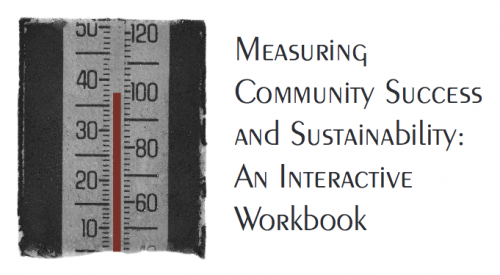Measuring Community Success and Sustainability: An Interactive Workbook describes a process to help communities learn how to measure the local or regional impacts of economic and community development processes that enhance rural community sustainability. The principal purpose is to help communities learn how to measure the concrete results of rural community development and conservation efforts. The entire process is anchored in research that determined the ways in which communities define success in their local development efforts. The measures that came from those communities were analyzed in terms of existing research on community and ecosystem sustainability.
The workbook provides guidance to communities, nonprofit organizations and agency personnel who want to get a better idea of the possible ways to gather information that details progress toward community-established outcomes.
Rural communities use these outcomes to develop practical ways to measure progress toward both them and locally-established goals in terms of outputs, activities and inputs. Communities can relate their projects to the various outcomes and pick a single measure of that outcome from the menu or design their own measure. To date, a number of communities and multicommunity groups, such as Resource Conservation and Development Councils, have found the menus serve a basis to create their own measures to gather over time. Nonprofit organizations and agencies can then aggregate the data from each community by outcomes to report multi-area impacts over time. The principal purpose, however, remains to provide a way for local communities to measure progress toward local goals. A vital community has the capacity to use, sustain and renew the resources and skills it needs to thrive over time—and to become the kind of community its residents want it to become. Measurement gives feedback to make communities more effective.
[ read the Workbook ]
Contents
- Preface
- How Do Vital Communities Spell Success?
- Performance Based Measurement and Community Building: Outcomes, Outputs, Activities and Inputs
- Planning for Action
- An Introduction to Measuring
- Measurement Vocabulary
- Sample Indicators and Measures for Each of the Five Outcomes
- Outcomes and Measurement
- Outcome 1: Increased Use of the Skills, Knowledge and Ability of Local People
- Examples of Indicators and Measures for Outcome 1
- Creating a Measurement Plan for Goals Related to Outcome 1
- Outcome 1: Case Study
- Measurement Plan
- Community Year-end Assessment for Outcome 1
- Outcome 2: Strengthened Relationships and Communication
- Examples of Indicators and Measures for Outcome 2
- Outcome 2: Case Study
- Measurement Plan
- Community Year-end Assessment for Outcome 2
- Outcome 3: Improved Community Initiative, Responsibility and Adaptability
- Examples of Indicators and Measures for Outcome 3
- Outcome 3: Case Study
- Measurement Plan
- Community Year-end Assessment for Outcome 3
- Outcome 4: Sustainable, Healthy Ecosystems with Multiple Community Benefits
- Examples of Indicators and Measures for Outcome 4
- Outcome 4: Case Study
- Measurement Plan
- Community Year-end Assessment for Outcome 4
- Outcome 5: Appropriately Diverse and Healthy Economies
- Examples of Indicators and Measures for Outcome 5
- Outcome 5: Case Study
- Measurement Plan
- Community Year-end Assessment for Outcome 5
- Afterword
Format
Source





